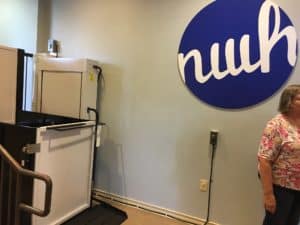
I arrived at church recently to find a shiny new addition nestled near the stairs that lead from the sanctuary building to the education building. Since I started using a walker ninety percent of the time, I rarely look that direction because I can’t navigate the steps necessary to access the breezeway that leads to the other building. But this day I saw a beautiful chairlift that will allow people in wheelchairs or with a myriad of mobility issues to get between the first floors of these two buildings. They no longer have to go outside and traveling through the parking lot to the outdoor ramp.
But it’s the journey to this moment that brings with it the lesson I needed to learn. My loss of mobility had purpose. My weakness could be of use to others. Change doesn’t happen magically. It requires my participation. My willingness to do the work. Our participation and our willingness. The lesson began more than a year ago when I shared with my Wednesday night Bible study class that whenever I stepped from my car into the closest accessible parking spaces after a hard rain, I landed in water that covered the top of my shoes. The rainwater from gutters poured into those spaces and pooled there because of poor drainage.
It just “happened” that a member of our board of trustees attended that class. It just “happened” that the trustees were preparing to do an annual accessibility inventory required by the conference. She asked if I would be willing to share my observations about the church’s accessibility (or lack thereof) with the board chairwoman. I said yes.
The board chairwoman asked me to sit on an accessibility committee that would make recommendations to the full board regarding accessibility deficits and how to correct them. I said yes. So did several other people. The committee made recommendations. The trustees and the Administrative Council approved substantial funding for the improvements, even when costs went above initial estimates. The board of trustees worked with a consultant (who “happened” to be married to a church member) familiar with accessibility requirements to vet their plans and recommendations. They hired a project manager who “happened” to be a church member and gave us a great deal.

In February we had an Accessibility Awareness Month in which we shared with the congregation the improvements being made and why they were necessary. I talked about my motor neuron disease PLS compounded by cancer treatment for Stage IV ovarian cancer. Others talked about autism, hearing limitations, and sight limitations. We shared how difficult it can be to use our spiritual gifts and be part of the body of Christ in a church building that limits our access. We shared Scripture that commands us to include everyone regardless of disability in the body of Christ. The congregations responded with enthusiasm for the improvements.
In the last year, we’ve seen improvements in the parking lot to correct the drainage issue, restriping and reconfiguration of parking to better locate accessible parking spaces. Improvements also included installation of a new ADA compliant wheelchair ramp outside the education building, installation of automatic doors in several locations, and the most recent installation of the lift. The church purchased fidget kits for children on the autism spectrum to use during services. Large print hymnals and Bibles are kept near the sanctuary entrance now. We still have work to do, including bathroom makeovers, an accessible path to the playground, and wheelchair spaces in the sanctuary, but we’ve made huge progress.
To be clear, this issue has come up before in my church. The ask had been made before. Even as far back as the nineties when I served on the stewardship committee that raised money for the then new sanctuary building. The original budget included the lift, but it had to be sacrificed when the budget exceeded funding.

The moral of the story is if something is a deterrent to my participation in worship and utilization of my spiritual gifts, I must say something. And then do something. The two go hand in hand. It’s been proven repeatedly if you ask people to volunteer on a project, they will say yes. God has a plan and he makes a way.
Coincidence doesn’t exist. Things don’t just “happen.” God puts people where they need to be in order to carry out his plan. I went to that Bible study and crossed paths with the trustee and God did the rest in his timing. Why now and not before? I don’t know. I do know that working on this project gave meaning to what seemed meaningless to me—the loss of my ability to walk unaided. God gave me a purpose. He allowed my weakness to work for others who need that chairlift and those automatic doors. I don’t get to sit on the sidelines and use my weakness as an excuse for not participating.
I have attended this church for almost 25 years and yet I never noticed the problems with accessibility until my own mobility became limited. How is that possible? I find it shameful. Only through my weakness did I find my eyes opened. Then I said yes.
What project do you need to say yes to today? How can God use your weakness for the benefit of others?
If you live in Northwest San Antonio (TX) and are looking for a church home, consider visiting Northwest Hills United Methodist Church. We’re working hard to include everyone in our activities and missions. Here’s a link to the website: https://www.nwhills.org/
If you have children on the autism spectrum, be sure to ask for our fidget kits when you enter the sanctuary. Our greeters can help you locate them by the sanctuary doors. We also have hearing assistive devices and large print hymnals.
